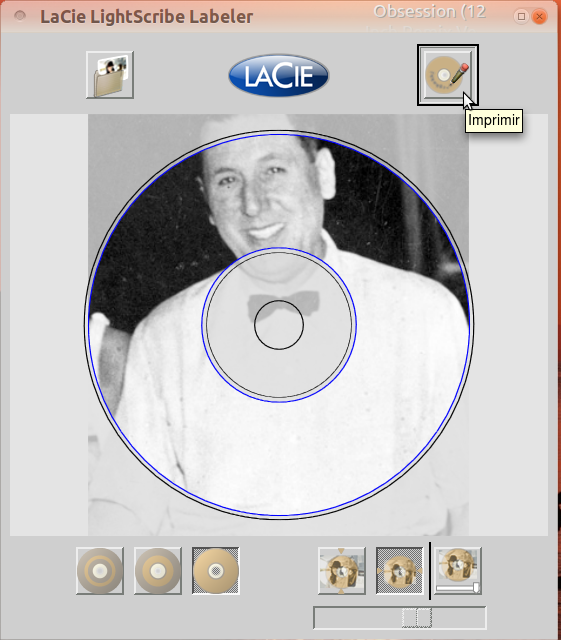

- #Lacie lightscribe labeller mac osx#
- #Lacie lightscribe labeller install#
- #Lacie lightscribe labeller update#
- #Lacie lightscribe labeller Pc#
There are eighteen, starting templates with typical user motifs: disc storage of baby or dog pictures, music or portfolios, office data, or travel/party pix. You can drag and drop images and text and rearrange those elements around the useable circular disc area.
#Lacie lightscribe labeller mac osx#
The LaCie d2 drive comes with LightScribe Labeler software in versions for both MAC OSX and Windows PCs allowing you to custom design your CD/DVD's label using an intuitive program. Surely your CD/DVD disc will stand out amongst discs with inkjet-printed paper labels! The LightScribe image is hologram-like in a gold-sepia tone and looks like it was produced at a big record label factory. Check: LightScribe technology, designed and licensed by the Hewlett-Packard Company, is a new way to use the same laser that burns data on the disc to burn permanent, silkscreen-quality images directly on the other side of the disc. Nowadays these discs can be played back via a wider range of devices (DVD players, car CD players, other computers, etc). CD speeds are: CD-R: 40x CD-RW: 24x CD-ROM: 40x. It is great to have a fast, 'current' CD/DVD disc burner and this one Rocks to 11! Specs are: Digital Audio rip speed: 40x DVD speeds for DVD+RW: 16x4x16x DVD-RW: 8x4x16x DVD+R DL: 2.4x.
#Lacie lightscribe labeller Pc#
It also connects to your PC or MAC computer by way of either high speed USB 2.0 or FireWire and features LightScribe Technology. It records CD-R/RWs and double layer DVD+R, DVD±R/RW discs for up to 8.5GB DVD videos. There are quite a few notable features in this new LaCie aluminum d2 drive. Go To The Music Connection "New Toys" Directory ||| Warning: Use the –scripts parameter to include the scripts.LaCie d2 CD/DVD±RW Burner with LightScribe Technology ||| Warning: Skipping conversion of scripts in package lightscribe: postinst preinst prerm ||| (Reading database … 133824 files and directories currently installed.) Selecting previously deselected package 4l. Ldconfig deferred processing now taking sudo dpkg -i 4l_1.0-2_all.deb Unpacking lightscribe (from …/lightscribe_1.10.27.1-2_all.deb) … (Reading database … 133693 files and directories currently installed.) Selecting previously deselected package lightscribe. $ fakeroot alien lightscribe-1.10.27.1.tgz Warning: Use the –scripts parameter to include the scripts. Warning: Skipping conversion of scripts in package lightscribe: postinst preinst prerm

#Lacie lightscribe labeller update#
Update 3: Paul Bailey has distilled the above into a simple recipe. Update 2: It works! I’ve successfully used the GUI to label a CD as a test. Update: I’ve since spotted that dpkg has a –force-architecture option, this may avoid the need for converting the lightscribe package. lightscribe_1.10.19.1-2_all.debĪnd it seems to work (though I have no Lightscribe media to test with yet!): Then it’s the usual installation procedure of: $ fakeroot alien lightscribe-1.10.19.1.tgz Then I converted the two tar files straight back into. Then I installed fakeroot and alien and converted both of them to TAR files thus: deb and the Lacie 4L package (which has a nice GUI) as the x586 RPM. Then I downloaded the Lightscribe System Software as a 32-bit.
#Lacie lightscribe labeller install#
So, to help others, this is the hack that I did to install it successfully.įirst I had previously installed the 32-bit compatibility libraries for AMD64 thus: Problem is that I’m running a 64-bit version of KUbuntu Linux (as it’ll have 8GB RAM once the final sticks arrive) and the closed source Lightscribe software is 32-bit only and won’t install without a bit of prodding.

I have a new AMD64 compatible system (an Intel quad core box) which comes with an ASUS DRW-1814BLT Lightscribe DVD burner. Caveat: Whilst the below works for me for those particular applications you may find that other 32-bit only applications require a fuller 32-bit environment, which you can get using a separate install of a 32-bit Ubuntu (often called a “ chrooted environment”) – please see the corresponding Ubuntu Wiki page for more information.


 0 kommentar(er)
0 kommentar(er)
